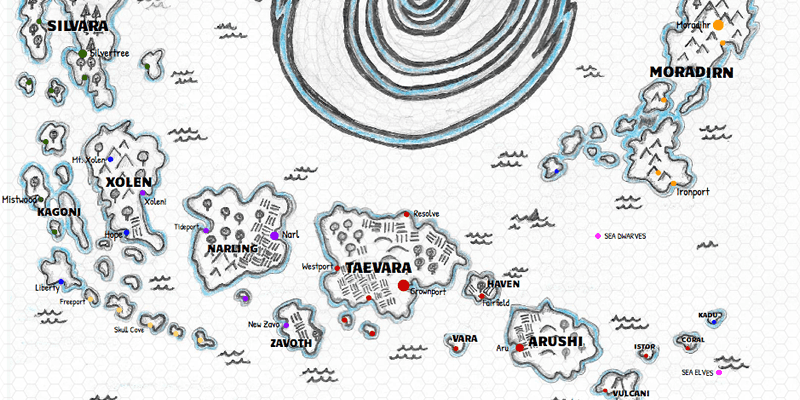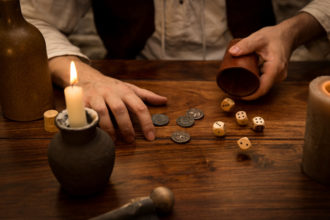Writing a Player’s Guide for Your New Campaign

I thought it might be a good idea to look at creating Player’s Guides on this week’s trip down the Campaign Trail. I’ve written more than a few Player’s Guides for my campaigns over the years from simple bullet lists to 30 page documents. Whether you’re running a simple published one-shot adventure or a from scratch homebrew campaign, a guide to provide players is always a handy tool. As a gamemaster, you need to supply your players with the specific details they need for character creation, an overview of the setting and any rules information (homebrew or published). This will let players decide if a campaign is right for them and provide them with materials to prepare for the first session.
I’m pretty busy this week preparing for the first session this year for my Friday night game, preparing for my new campaign that is starting next month and that annoying thing called work that gets in the way of the other two. We’re going to start the new campaign with a character creation session, so my player’s need some information to be able to come to the session fully prepared.
Tips on Writing Player Guides
Steal from Published Guides
Check out any player guides your have on your bookshelf. If you look at the Sword Coast Adventurer’s Guide, you’ll find a long example of how to provide detailed setting information and player character options. An even better source for ideas are the excellent free guides for Pathfinder Adventure Paths such as the 30 page Skull & Shackles Player’s Guide.
Write Only What is Needed
- Write only what your player’s need. A huge tome will either not be read or important details will be missed.
- Make sure to start by giving them a quick intro about what the campaign and setting are all about.
- A homebrew campaign is going to need more material than a campaign that is using a premade published world. When deciding to tackle a homebrew world for your next campaign, don’t forget to consider all the extra written work to support your players that will be needed after your world building. I provide an example below of what I provided in a longer player guide from my homebrew campaign.
- Make sure your guide’s length and style matches your audience and campaign need. A short post for potential players you are recruiting for an online one-shot game is a much different audience than your group you’ve played a home game with full of house rules for decades.
Recruiting
If you are recruiting players, think about creating a mini player’s guide that is more of an promo to get them interested. They can read the full version once they sign up. Make sure to clearly outline setting, play style and tone, and rules when recruiting to make sure you don’t waste the time of recruits and yourself. A campaign is a major commitment, so give the essential info needed so people can decide if they want to invest in your campaign.
Maps & Visuals
Provide maps and other visuals to help players imagine the world and their character’s place in it. If you aren’t an artist try to recruit help from a talented player or even try to purchase artwork. Take a crack at drawing a map like I did. I’m not gifted cartographer, but I know the world better than anyone. I recently purchased How to Draw Fantasy Art & RPG Maps, so my next map will be better.
Living Documents
Consider creating a wiki, forum or other living online document (Google Docs, Office, Dropbox) that you and your players can update as the campaign evolves over time.
Player Guide Basics
It doesn’t matter if you’re running a campaign in a published world or if you’ve created your own world from scratch, your players (or potential players if you are recruiting) will need to know the following:
- Which rules are we using? Are there any homebrew/table rules?
- What do I need to know about the setting and style of play?
- What player options are available to me for races, classes and backgrounds? What hooks are there to fit my player character into the world?
- How are we rolling stats? Standard Array, Point Buy or dice rolls at the character creation session?
- What level are we starting at?
- What gold, equipment and magic items do I start with?
- When (and how often) you will play, how long sessions will last and where you will play (physical location or which online tools)
- Other info such as:
- table rules/etiquette
- any supporting homebrew content for custom races, classes, equipment or spells
- table of content for longer documents
A guide doesn’t have to answer all of the above, but a good guide will answer everything a player needs to decide if the campaign is right for them and to prepare for your first session.
Example Short Player Guide
Here’s an example of a short player guide I provided potential players my Adventure Time Campaign on Roll20 way back in 2014.
We’re a group of adventurers brought together to play a homebrew mod of D&D 4e based on the Cartoon Network show Adventure Time.
THE GAME
Adaptation of the Dungeon and Dragons 4th Edition, set in the awesome Adventure Time universe. Roles include Doctor, Scientist, Minstrel, Warrior, Thief and Wizard and 16 races include Candy, Bear, Ice, Cloud, Hot Dog, Flame, Lumpy Space, Breakfast, Crystal and more.
THE SETTING
In the questionably distant future there exists the Land of Ooo, and it is a place of wonder and mystery populated by goblins, wizards, ogres, candy people, and countless other weird and amazing creatures. It is a world renewed after an unknown cataclysm, a world of magic and heraldry built upon the mysterious ruins of our present. This is the land in which Adventure Time takes place.Watching Adventure Time isn’t required to play this game, although it will explain some of the lore and will allow player and dungeon master alike to interweave fun and exciting tidbits from the show into their games.
NOTES
- 4e core books + the AT guide are the rules for this game. magic seems to focus a bit more on cantrips and the character stuff is unique, but really just DnD 4e. Levels 1-5, so pretty basic, focus on fun.
- The DM runs fun little episodic adventures, but you never know when something dark could come along (just like the show) requiring an epic quest to save Ooo.
- Here is the homebrew handbook for Adventure Time
- Here is the character generator
- NOTE FROM HOMEBREW CREATOR – “Though I’m not releasing a new version just for this, people reading this original post should note that hit points should be initially calculated using your constitution SCORE, not your constitution MODIFIER. This has been rectified in the character generator.”
This block of text provides answers to most of the questions to potential players and is short enough that it was read. I didn’t provide what level they start at, how we’re to roll stats and what equipment we start with… but I did handle that in follow-ups with my shortlist of recruits from the pool of prospects. In the future, I’d make this a little longer and provide those details up front.
Example Longer Player Guide
The guide I provided players for my current Vodari campaign started much shorter and grew to 30 pages by the end as I added more appendices. I don’t recommend creating a guide this long, and I’ll have to ask my players if it was too long… but my player have the details they needed to create characters in this homebrew world. I have even had them refer back to the guide to remind me of a forgotten detail on a few occasions.
This guide didn’t cover what rules we would be using, when we’d play and what tools we would use to play online (we covered all of this on our shared message board in Roll20).
Here is a condensed version of what this guide contains.
- Table of Contents
- Welcome to Vodari: 500 word outline of the setting and its history including a full page map
- Character Creation: Quick outline of 4 steps of character creation similar to material provided in the D&D 5e Player’s Handbook, including that we would be using the standard array of 15, 14, 13, 12, 10 and 8 for “rolled” ability scores.
- Races: I provided about half a page with hooks and details on playing each race and subrace in Vodari. I also provided full stat and trait information for homebrew subraces such as Sea Elves and Ice Dwarves and a Minotaur homebrew race
- Classes: 3 pages of ideas for playing classes in Vodari and notes on what playtest and splat material could be used (such as Rogue – Swashbuckler, Sorcerer – Storm and Fighter – Mariner) to play a homebrew Sorcerer – Aquatic and Warlock – Sea Witch
- Backgrounds: 7 pages of custom backgrounds for the campaign including Castaway, Cartographer, Privateer, Doctor, Miner and Tinkerer
- Feats: 2 pages of homebrew feats: Deck Brawler, Flintlock Expert, Increased Critical and Nimble
- Equipment: 3 pages of equipment mostly to handle the use of flintlock guns, cannons and to provide seafaring gear like eye patches, hats and sextants
- Appendices: I also provided 8 detailed appendices that covered specifics needed to flesh out the details for my homebrew world of Vodari.
- APPENDIX A: GODS OF VODARI
- APPENDIX B: PIRATE’S CODE
- APPENDIX C: PRIVATEER’S CODE
- APPENDIX D: SHIPBOARD CONDUCT
- APPENDIX E: SHIPBOARD ROLES
- APPENDIX F: PIRATE SPEAK
- APPENDIX G: TYPES OF SHIPS
- APPENDIX H: CALENDAR
Closing Thoughts
The guide for my upcoming campaign set in the published Nentir Vale setting is only around 5 pages (so far), with most of that being a quick primer on the setting and what player options are available. I’m publishing the Nentir Vale player guide on our message board versus maintaining a full Word document shared as a PDF over dropbox like I did for Vodari. I have no idea how long your player guide should be, but hopefully my ramblings above will be helpful.




